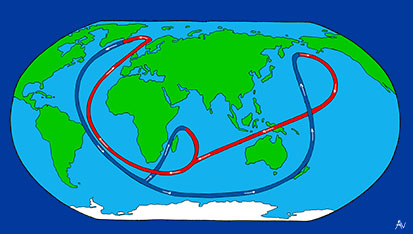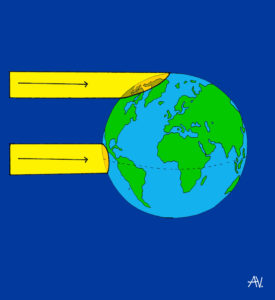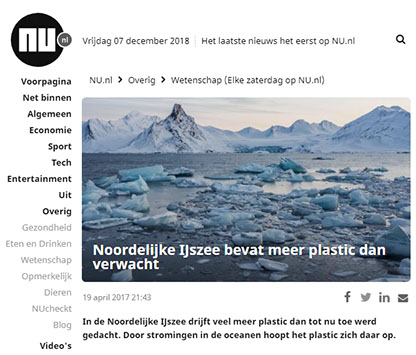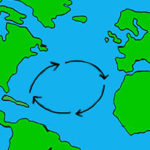Why do we find Dutch plastic at the North Pole?
Plastic that gets carried from the Netherlands to the ocean collects in the North Atlantic gyre, or it gets stuck in the Arctic Ocean.

Did you know… It can take 450 years before a plastic bottle is completely broken down in the ocean.
The gyres are not the only place where plastic collects in the ocean; it can also get trapped at the North Pole. Surface currents can carry plastic towards the North Pole, where the water sinks from the surface to the ocean floor thanks to the ‘ocean conveyor belt’. The floating plastic carried along on the surface currents stays at the surface, however, where it accumulates in the Arctic region.
What is the ‘ocean conveyor belt’?

Thermohaline circulation, also known as the ‘ocean conveyor belt’, is the global system of ocean currents.
The ‘ocean conveyor belt’ is the global system of ocean currents. Thanks to this ocean conveyor belt, the oceans are in constant movement, exchanging warm water from the ocean surface with cold water from the deep sea.
How does the ocean conveyor belt work?
The scientific term for the ocean conveyor belt is ‘thermohaline circulation’, from the Greek words for heat and salt. As its name implies, the ocean conveyor belt is powered by the ocean’s salt content and temperature. Salt water is heavier than fresh water, and cold water is heavier than warm water. As a result, cold, salty water sinks below the warmer, less salty water, which stays at the surface. The difference in the ocean’s salt content and temperature is caused by the difference in temperature at the equator and the poles.
Why is the equator warmer than the poles?

The sun’s radiation at the equator is greater than at the North- and South poles, because the sun shines on a smaller proportion of the sun’s surface.
The areas around the equator are warmer because the sun shines directly at them. A lot of sunshine is focused in a small area, so the ‘irradiation’ is greater there. Polar regions are colder. These regions receive the same amount of sunshine, but thanks to the curvature of the earth it is spread over a larger surface area.
Difference in salinity due to solar irradiation
Since the equatorial region is warm, seawater evaporates and becomes saltier, which makes it heavier. But the water around the equator is still warm enough to keep it from sinking, even though it is relatively salty. As the warm, salty water flows towards the poles, however, it begins to cool off. Cold water is heavier than warm water, and near the poles the heavier, saltier water sinks to the bottom again.
Dutch waste threatens the North Pole

Read how plastic in the Arctic collects in a ‘polar graveyard’ on nu.nl (in Dutch).
By the time it reaches the Arctic Ocean, the warm surface water flowing from the equator has cooled enough that it can sink to the ocean floor. The floating plastic carried along on the surface currents stays at the surface, however 1. The earth is heating up due to climate change, and the warmer temperatures are affecting the Arctic and everything that lives there. As a result, the Arctic is increasingly polluted with plastic, which has major detrimental effects on the animals that call it home. If you would like to know more about the harmful effects of plastic in the Arctic, read this article at nu.nl (in Dutch).
More interesting info…





